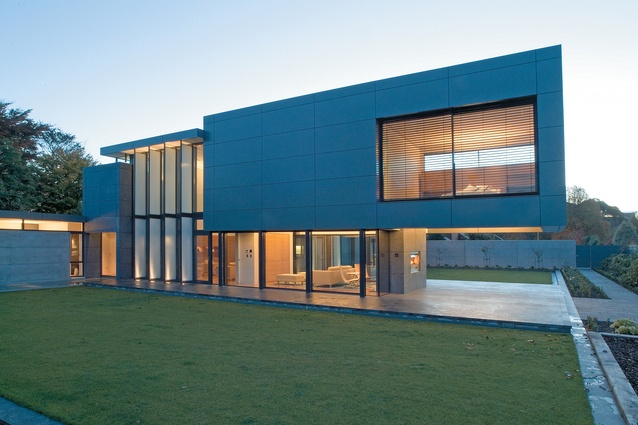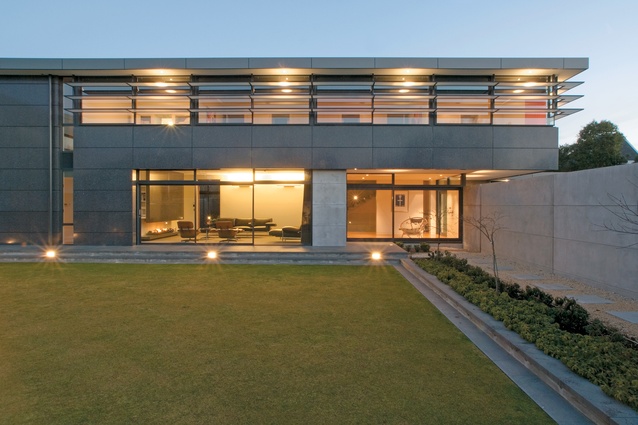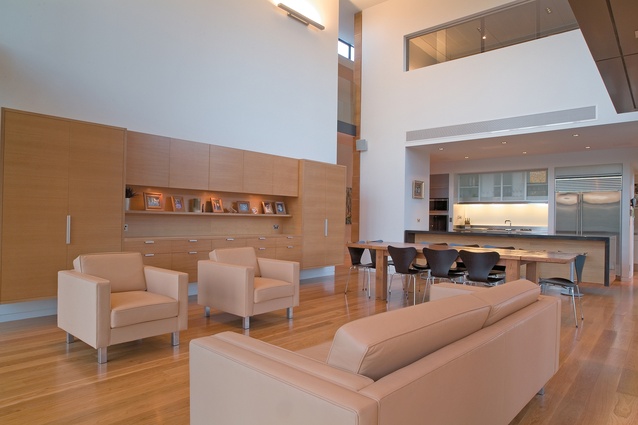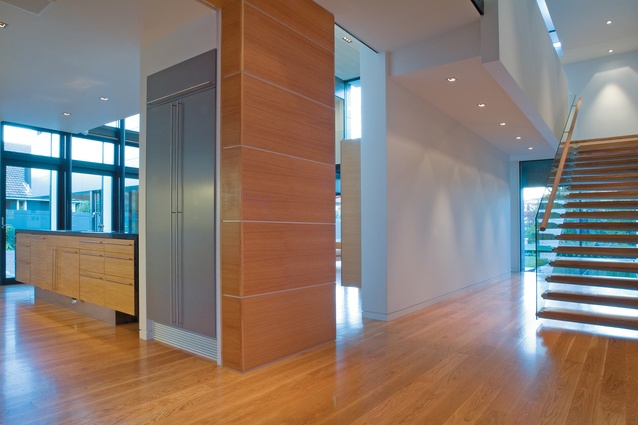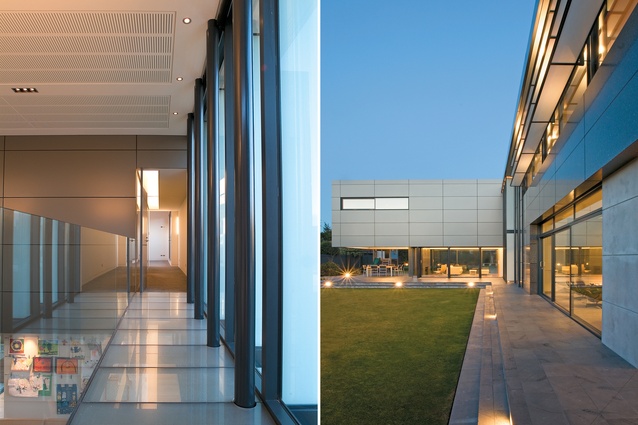Houses Revisited: Rationalist house
In this large Christchurch house, Wilson and Hill Architects continue their exploration of contemporary Modernism, first published in 2006.
When Group Architects built their Experimental house in Takapuna in 1950 they posited a distinctly New Zealand brand of modernism, incorporating light-weight timber construction, a low pitched roof, a free plan and the interpenetration of indoor and outdoor space. Later in the decade Miles Warren, first at the celebrated Dorset Street Flats in Christchurch and then in a series of houses in Christchurch and surrounding districts, developed a domestic idiom that retained the Group’s innovations in plan and connection with the outdoors but also embraced the sense of mass that only masonry construction could provide. Low-pitched roofs were replaced by traditional gables and ridgelines, derived from contemporary Scandinavian domestic architecture as well as the arts and crafts-inspired houses of Christchurch’s inner suburbs.
The capacity for modernism to evolve was called into question by the post-modernism of the 1980s, in which gratuitous and often clumsy references to the classical tradition were crudely superimposed on what remained a fundamentally modernist design approach. The shams of post-modern classicism have now, for the most part, been abandoned. Since the mid-nineties Modernism has reasserted its position as a design philosophy but now that the heroic Modernism of the 1920s and 1930s has been consigned to history, to be re-examined in books and major exhibitions such as the Victoria and Albert Museum’s Modernism: Designing a New World, its tenets have fundamentally changed. Whereas Modernism in the early twentieth century sought to change the world, it has now become the architecture of the establishment: the cutting-edge flimsiness of the Group’s Experimental house has been transformed into the assured substantialness of the early twenty-first-century modern house. Just as the glass curtain-walled office tower became, in the 1950s, the architectural signboard of corporate capitalism, so in the domestic realm Modernism has taken on new meanings.
The Christchurch architectural firm Wilson and Hill has achieved considerable success with a series of large, meticulously detailed and well-crafted houses that take up the challenge of exploring contemporary Modernism, a tautology that would have been unthinkable 50 years ago. Their houses on Carlton Mill Road (2001) and Thornycroft Street (2003) have each received NZIA New Zealand awards, as has their recently completed house on Clyde Road (2006). The Clyde Road house, on a large back section opposite the University of Canterbury, was built for a professional couple with a large family. The generous, rectangular lot is approached by a tree-lined driveway of surprising breadth, down which the angular mass of the house rises beyond a concrete panel wall that separates the private garden from the paved forecourt.

The house itself is essentially L-shaped in plan. A spacious circulation spine extends the full length of the main wing, its length emphasised by a reflecting pool of similar breadth that extends eastwards into the garden. Stairs of cantilevered, pre-cast treads rise to the first floor at either end of this space, obviating the need to trek from one end of the house to the other to gain access to the upper level. Along the north side of the long axis are the formal reception area, kitchen and scullery, and an expansive double-height living room. This opens to the north into a family room with a covered, outdoor dining space beyond. Storage, formal dining and a home theatre lie to the south of the gallery-like circulation space.
On the upper level, a string of children’s bedrooms extend along the main east-west wing, separated from the parents’ bedroom wing by the void of the living room. This separation is reinforced by the mode of access to the master bedroom, across a glass-floored bridge, which also forms a gallery at the eastern end of the living room. The visual insubstantialness of this drawbridge-like feature, suspended in space alongside floor-to-ceiling windows, induces a sense of psychological unease, although safety is never compromised. A similar sense of risk is induced by the five-metre cantilever of the master bedroom, which forms the canopy over the outdoor dining area. The visual support for this element, a series of widely spaced and slender pilotis, again reads as insubstantial, despite the fact that reason dictates that the structure is up to the task. From the exterior, the master bedroom suite reads as a distinct element, clad in grey aluminium panels and hovering above the fully glazed family room below. The visual lightness of this wing contrasts with the solidity of the main living and bedroom wing, which is constructed of thermomass concrete panels with dark grey terrazzo cladding above.
The muted exterior palate of unpainted concrete, terrazzo and aluminium cladding, is emphasised by the use of Timaru bluestone paving which extends the narrow colour range into the garden. On the interior visual warmth is provided by the American white oak used for the floors of the living spaces, with the exception of the formal sitting and dining areas. Quarter-sawn white oak is also used as a wall surface along the north wall of the circulation gallery and for fittings in the living and family rooms. Extending the continuity of the exterior aesthetic, terrazzo is employed for chimney breasts in the interior, while the aluminium cladding of the master bedroom wing wraps around the interior wall it shares with the living room. This material repetition further signals the discreet, pod-like nature of the wing. At any moment, it seems, it could detach itself and float away.

Another conspicuous feature of the exterior are the sun screens, vertical against the north and east walls of the living space, horizontal along the north-facing bedroom windows. The screens themselves are of white, translucent glass, which provides shade from the sun while reflecting diffused light into the rooms beyond. When illuminated at night, the screens gently glow. Such details are indicative of the meticulousness of the architects’ approach to the overall design, which evolved over two years. The further two years required to build the house indicates the unusually demanding construction process, more akin to that of a commercial building than a house. It also signifies the architects’ efforts to futureproof the house with state-of-the-art electronic systems, which integrate lighting, security and audio functions throughout the building.
The architects and their clients worked together in furnishing the house, ensuring there are none of the clashes of architecture and applied art that can easily undermine the most carefully wrought plans. Collaboration between the architect and artist Bing Dawe has resulted in a custom-sized rug from Dawe’s Eels & Shags (Migration) series, created by Dilana Rugs, for the living space. The extensive interior wall surfaces of the house cry out for additional artworks of this scale and boldness; in their absence, the interior spaces appear lived in but not yet fully inhabited.

For all the attention that Wilson and Hill have paid to creating a liveable environment which is able to accommodate Canterbury’s climatic extremes, yet also preserve links between interior and exterior spaces, the indefinable quality of the domestic realm remains rather elusive. Is this a function of scale of the house, of the rigorousness of the plan with its precise differentiation of zones, of the carefully controlled palette of materials, or simply of the tyranny of the right angle? Even at their most rigorous, the early masters of the modern movement recognised that houses demand some expression of play, some quality of the unpredictable and irrational. For example, Mies van der Rohe’s Tugendhat House (1928-30) in Brno, Czech Republic, employed a sensuously curved wall as a space divider. Le Corbusier, too, recognised the power of curving forms and ramps that sliced through space, as well as the value of juxtaposing coarse, unfinished materials with pristine surfaces.
The interplay of sensuousness and precision within the architecture of early Modernism is also apparent in the work of David Chipperfield, the contemporary English architect who has been an ongoing point of reference for Chris Wilson. As Chipperfield himself has recognised in his own works, the rough-textured brickwork of Mies’s Berlin houses of the twenties and the spiral staircases of Le Corbusier’s early villas are as much a part of Modernism’s heritage as the movement’s allegiance to the machine aesthetic. No architect recognised Modernism’s potential to lead up blind alleys more clearly than Frank Lloyd Wright, an architect whom Wilson clearly admires. Yet even Wright’s most problematic houses from the late twenties and early thirties, which bear some relationship to Wilson and Hill’s work, have a spatial complexity that transcends rational analysis.
Modernism’s legacy remains a problematic one. In its name, the hearts of great cities have been destroyed and acres of soulless, mass public housing have been constructed, but Modernism has also inspired buildings of incontrovertible virtuosity and expressive power. Since Modernism seems certain to remain a source of potent ideas for contemporary architects – in New Zealand as much as elsewhere – for the foreseeable future, it is essential that attention is paid not just to the rationalism that was used to validate the twentieth century’s architectural revolution, but also to Modernism’s underlying contradictions – to its richness and complexity, and its underlying irrationalism.
Click here to see more Houses Revisited. And sign up to our email newsletters to receive Houses Revisited straight to your inbox.
Note: These are stories from our archives and, since the time of writing, some details may have changed including names, personnel of specific firms, registration status, etc.

